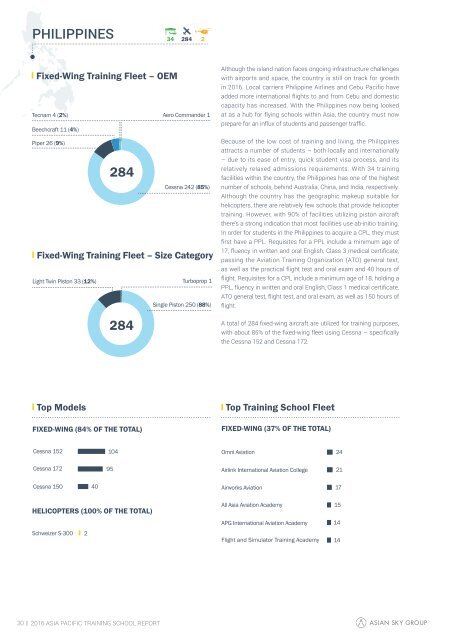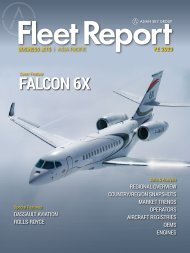Create successful ePaper yourself
Turn your PDF publications into a flip-book with our unique Google optimized e-Paper software.
PHILIPPINES<br />
34 284<br />
2<br />
Fixed-Wing <strong>Training</strong> Fleet – OEM<br />
Tecnam 4 (2%)<br />
Beechcraft 11 (4%)<br />
Piper 26 (9%)<br />
85+10+4+1+0+G<br />
284<br />
88+12+0+G<br />
Aero Commander 1<br />
Cessna 242 (85%)<br />
Fixed-Wing <strong>Training</strong> Fleet – Size Category<br />
Light Twin Piston 33 (12%) Turboprop 1<br />
284<br />
Single Piston 250 (88%)<br />
Although the island nation faces ongoing infrastructure challenges<br />
with airports and space, the country is still on track for growth<br />
in 2016. Local carriers Philippine Airlines and Cebu Pacific have<br />
added more international flights to and from Cebu and domestic<br />
capacity has increased. With the Philippines now being looked<br />
at as a hub for flying schools within Asia, the country must now<br />
prepare for an influx of students and passenger traffic.<br />
Because of the low cost of training and living, the Philippines<br />
attracts a number of students – both locally and internationally<br />
– due to its ease of entry, quick student visa process, and its<br />
relatively relaxed admissions requirements. With 34 training<br />
facilities within the country, the Philippines has one of the highest<br />
number of schools, behind Australia, China, and India, respectively.<br />
Although the country has the geographic makeup suitable for<br />
helicopters, there are relatively few schools that provide helicopter<br />
training. However, with 90% of facilities utilizing piston aircraft<br />
there’s a strong indication that most facilities use ab-initio training.<br />
In order for students in the Philippines to acquire a CPL, they must<br />
first have a PPL. Requisites for a PPL include a minimum age of<br />
17, fluency in written and oral English, Class 3 medical certificate,<br />
passing the Aviation <strong>Training</strong> Organization (ATO) general test,<br />
as well as the practical flight test and oral exam and 40 hours of<br />
flight. Requisites for a CPL include a minimum age of 18, holding a<br />
PPL, fluency in written and oral English, Class 1 medical certificate,<br />
ATO general test, flight test, and oral exam, as well as 150 hours of<br />
flight.<br />
A total of 284 fixed-wing aircraft are utilized for training purposes,<br />
with about 85% of the fixed-wing fleet using Cessna – specifically<br />
the Cessna 152 and Cessna 172.<br />
Top Models<br />
FIXED-WING (84% OF THE TOTAL)<br />
Top <strong>Training</strong> School Fleet<br />
FIXED-WING (37% OF THE TOTAL)<br />
34+0+31+0+13<br />
Cessna 152 104<br />
Cessna 172<br />
Cessna 150<br />
40<br />
95<br />
HELICOPTERS (100% OF THE TOTAL)<br />
Omni Aviation<br />
Airlink International Aviation College<br />
Airworks Aviation<br />
All Asia Aviation Academy<br />
APG International Aviation Academy<br />
1<br />
Schweizer S-300 2<br />
Flight and Simulator <strong>Training</strong> Academy<br />
7+0+7+0+6+0+5 +0+5+0+5<br />
24<br />
21<br />
17<br />
15<br />
14<br />
14<br />
30 | 2016 ASIA PACIFIC TRAINING SCHOOL REPORT

















